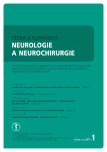An Association Between Early Metabolic Changes in the Brain and Selected Baseline Parametres in Patients after Subarachnoid Haemorrhage Due to Ruptured Intracranial Aneurysm
Authors:
J. Adamkov 1; J. Náhlovský 1; T. Česák 1; J. Habalová 1; M. Kanta 1; J. Kremláček 3; A. Krajina 2; S. Řehák 1
Authors‘ workplace:
Neurochirurgická klinika LF UK a FN Hradec Králové
1; Ústav patologické fyziologie, LF UK v Hradci Králové
2; Radiologická klinika LF UK a FN Hradec Králové
3
Published in:
Cesk Slov Neurol N 2017; 80/113(1): 75-79
Category:
Original Paper
Overview
Aim:
In this retrospective study of patients with subarachnoid haemorrhage from a ruptured aneurysm we explored associations between the initial condition at the time of patient admission (clinical and radiological) and concentration of selected metabolites in the white brain matter as measured by microdialysis.
Methods:
We included 15 patients after subarachnoid haemorrhage who were treated surgically or endovascularly from 2012 to 2015. A probe measuring intracranial pressure and a microdialysis catheter for monitoring of the metabolic condition of the brain tissue were introduced following treatment. The condition of patients at the time of clinical admission was evaluated according to the Hunt-Hess scale. Images were assessed for the presence of global cerebral oedema. These parameters were statistically evaluated against lactate and pyruvate concentrations and their ratio.
Results:
Patients with global cerebral oedema had a statistically significantly lower concentration of pyruvate and a higher lactate/pyruvate ratio within the first 24 hours of monitoring. Patients with at least one episode of metabolic crisis (glucose < 0.7 mmol/l and lactate/pyruvate ratio > 40) showed statistically significantly higher value of lactate/pyruvate ratio during the first 24 hours. Furthermore, a statistically significant association was confirmed between severity of a patient’s baseline condition (Hunt-Hess 4) and concentration of lactate and lactate/pyruvate ratio within the first 24 hours of monitoring. A statistically significant association was also found between at least one episode of metabolic crisis during the entire monitoring and poorer clinical outcome 1 month after subarachnoid haemorrhage due to ruptured intracranial aneurysm (modified Rankin score 4–6).
Key words:
subarachnoid haemorrhage – neuromonitoring – microdialysis – global cerebral oedema
The authors declare they have no potential conflicts of interest concerning drugs, products, or services used in the study.
The Editorial Board declares that the manuscript met the ICMJE “uniform requirements” for biomedical papers.
Chinese summary - 摘要
关系早期在脑内代谢改变和选定蛛网膜下腔后,患者输入参数
从动脉瘤破裂出血
摘要
目标:
澄清代谢过程的关系监视的脑透析液放射学和临床参数的病人蛛网膜下腔出血后动脉瘤破裂。
方法:
在2012 - 2015年这项研究涵盖15例蛛网膜下腔后出血谁是手术或血管内治疗。在这些患者中,后
治疗与传感器出血源颅内压力导管的测量微透析监测脑组织的代谢状态。输入临床状态根据亨特 - 赫斯的规模,他进行了评价。当评估影像学表现关注全球脑水肿(GEM)的标识。这些参数是
统计学与乳酸盐,丙酮酸盐,以及它们的关系的浓度相比较。
结果:
在组患者的创业板是丙酮酸显著较低浓度和更高乳酸/丙酮酸比率在第一个24小时监视。患者
据报道代谢危机(葡萄糖<0.7毫摩尔/升的至少一个情节和乳酸/丙酮酸比值> 40)中首次展出的乳酸/丙酮酸比率较高的值24小时测量。此外,证实了较重的输入之间的统计学显著关系临床状态(亨特 - 赫斯4)和乳酸和值较高浓度最初的24小时监控中乳酸/丙酮酸比值。统计显著
关系也是代谢危机中的至少一个情节的存在期间蛛网膜下腔后全程监控,更糟糕的临床结果1个月
从动脉瘤破裂出血(改良Rankin比分4-6)。
关键词:
蛛网膜下腔出血 – 大脑检测 - 微透析 - 全球脑水肿
Sources
1. Prunell GF, Mathiesen T, Diemer NH, et al. Experimental subarachnoid hemorrhage: subarachnoid blood volume, mortality rate, neuronal death, cerebral blood flow, and perfusion pressure in three different rat models. Neurosurg 2003;52(1):165 – 75.
2. MacGregor DG, Avshalumov MV, Rice ME. Brain edema induced by in vitro ischemia: causal factors and neuroprotection. J Neurochem 2003;85(6):1402 – 11.
3. Vespa P, Bergsneider M, Hattori N, et al. Metabolic crisis without brain ischemia is common after traumatic brain injury: a combined microdialysis and positron emission tomography study. J Cereb Blood Flow Metab 2005;25(6):763 – 74.
4. Adamkov J, Náhlovský J, Habalová J, et al. Cerebrální vazospazmy po subarachnoidálním krvácení – možnosti diagnostiky, monitorace a léčby. Cesk Slov Neurol N 2014;77/ 110(2):158 – 67.
5. Claassen J, Carhuapoma JR, Kreiter KT, et al. Global cerebral edema after subarachnoid hemorrhage: frequency, predictors, and impact on outcome. Stroke 2002;33(5):1225 – 32.
6. Zetterling M, Hallberg L, Hillered L, et al. Brain energy metabolism in patients with spontaneous subarachnoid hemorrhage and global cerebral edema. Neurosurg 2010;66(6):1102 – 10. doi: 10.1227/ 01.NEU.0000370893.04586.73.
7. Helbok R, Ko SB, Schmidt M, et al. Global cerebral edema and brain metabolism after subarachnoid hemorrhage. Stroke 2011;42(6):1534 – 9. doi: 10.1161/ STROKEAHA.110.604488.
8. Harukuni I, Bhardwaj A. Mechanisms of brain injury after global cerebral ischemia. Neurol Clin 2006;24(1):1 – 21.
9. Qureshi AI, Sung GY, Suri MA, et al. Prognostic value and determinants of ultraearly angiographic vasospasm after aneurysmal subarachnoid hemorrhage. Neurosurgery 1999;44(5):967 – 73.
10. Hejčl A, Sameš M. Mikrodialýza v neurochirurgii. Cesk Slov Neurol N 2009;72/ 105(6):511 – 7.
11. Thal SC, Sporer S, Klopotowski M. Brain edema formation and neurological impairment after subarachnoid hemorrhage in rats. Laboratory investigation. J Neurosurg 2009;111(5):988 – 94. doi: 10.3171/ 2009.3.JNS08412.
12. Hillered L, Vespa PM, Hovda DA. Translational neurochemical research in acute human brain injury: the current status and potential future for cerebral microdialysis. J Neurotrauma 2005;22(1):3 – 41.
13. King JT jr. Epidemiology of aneurysmal subarachnoid hemorrhage. Neuroimaging Clin N Am 1997;7(4):659 – 68.
14. Hansen-Schwartz J, Vajkoczy P, Macdonald RL, et al. Cerebral vasospasm: looking beyond vasoconstriction. Trends Pharmacol Sci 2007;28(6):252 – 6.
15. Macdonald RL, Pluta RM, Zhang JH. Cerebral vasospasm after subarachnoid hemorrhage: the emerging revolution. Nat Clin Pract Neuro 2007;3(5):256 – 63.
16. Sehbaand FA, Friedrich V. Early microvascular changes after subarachnoid hemorrhage. Acta Neurochir 2011;110(1):49 – 55. doi: 10.1007/ 978-3-7091-0353-1_9.
Labels
Paediatric neurology Neurosurgery NeurologyArticle was published in
Czech and Slovak Neurology and Neurosurgery

2017 Issue 1
- Metamizole at a Glance and in Practice – Effective Non-Opioid Analgesic for All Ages
- Memantine in Dementia Therapy – Current Findings and Possible Future Applications
- Advances in the Treatment of Myasthenia Gravis on the Horizon
Most read in this issue
- Current Perception of Contraindications and Complications of Nerve Conduction Studies and Needle Electromyography
- Essential Neurological Examination – Time for Change?
- Extirpation of Colloid Cyst by an Endoscopic Approach
- Periodic Limb Movements During Sleep are More Severe in Narcolepsy with Cataplexy than in Narcolepsy without Cataplexy
